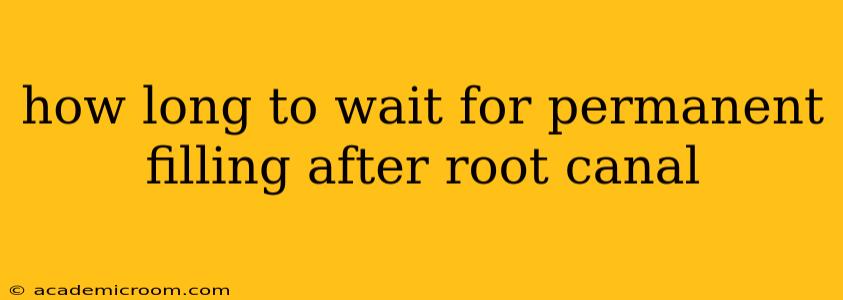A root canal is a significant dental procedure designed to save a severely infected tooth. After the infected pulp is removed and the canals are cleaned and sealed, the next step is restoring the tooth with a permanent filling. But how long should you wait? The answer isn't a simple number of days; it depends on several factors and ultimately your dentist's professional judgment.
What Happens During a Root Canal?
Before diving into the waiting period, let's briefly review the root canal process. A root canal involves:
- Accessing the Pulp Chamber: Your dentist drills a small opening into the tooth to reach the infected pulp.
- Removing the Infected Pulp: The inflamed or infected pulp is carefully removed using specialized instruments.
- Cleaning and Shaping the Canals: The canals are thoroughly cleaned and shaped to ensure complete removal of infection.
- Filling and Sealing the Canals: The canals are filled with a biocompatible material like gutta-percha to prevent reinfection.
- Temporary Filling: A temporary filling is placed to protect the tooth until the permanent restoration.
How Long Should You Wait for a Permanent Filling?
This is where it gets nuanced. There's no universally prescribed waiting period. Your dentist will assess several factors before scheduling the permanent restoration:
- The Extent of the Infection: A more severe infection might require a longer healing period to ensure the complete elimination of bacteria.
- Your Overall Oral Health: Pre-existing conditions or poor oral hygiene could influence the healing time.
- The Type of Permanent Restoration: A crown (a cap placed over the entire tooth) generally requires more time for preparation and fitting than a simple filling.
- The Dentist's Clinical Judgment: Your dentist's professional assessment is paramount. They'll consider all relevant factors to determine the optimal time for the permanent filling.
Generally, the waiting period can range from a few days to several weeks. Some dentists may opt for a temporary filling for a couple of weeks to allow for initial healing and to check for any lingering discomfort.
How Soon Can I Get a Permanent Filling After a Root Canal?
While some dentists might proceed with the permanent restoration fairly quickly, others might prefer a more conservative approach. The key is that you should follow your dentist's recommendations. They will assess your individual situation and determine the appropriate timeframe. Rushing the process could compromise the longevity of the root canal treatment.
What Happens if I Wait Too Long for a Permanent Filling?
Delaying the permanent restoration for an extended period could potentially expose the cleaned and filled canals to reinfection. This could lead to complications, necessitating further treatment.
What Type of Permanent Filling Will I Need?
The type of permanent restoration depends on several factors, including the location, size, and extent of damage to your tooth. Your dentist might recommend:
- A Simple Filling: For smaller cavities and minimal damage.
- An Onlay: A filling that covers a larger portion of the tooth's surface.
- An Inlay: A custom-made filling inserted into the tooth.
- A Crown: A cap that encases the entire tooth, providing maximum protection and stability.
Can I Eat Normally After a Root Canal With a Temporary Filling?
After a root canal with a temporary filling, it's essential to avoid chewing forcefully on the treated tooth to prevent damage to the temporary filling. Stick to a softer diet until the permanent restoration is in place.
In conclusion, there isn't a fixed timeframe for getting a permanent filling after a root canal. Your dentist's recommendation is crucial for ensuring a successful outcome. Open communication with your dentist about your concerns and any discomfort you experience is vital for optimal healing and the long-term health of your tooth. Remember to follow their aftercare instructions carefully.
